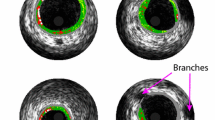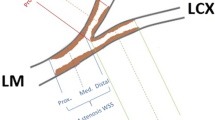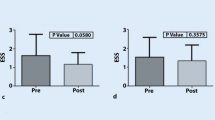Abstract
The relationship between high wall shear stress (WSS) and plaque rupture (PR) in longitudinal and circumferential locations remains uncertain. Overall, 100 acute coronary syndrome patients whose culprit lesions had PR, documented by optical coherence tomography (OCT), were enrolled. Lesion-specific three-dimensional coronary artery models were created using OCT data. WSS was computed with computational fluid dynamics analysis. PR was classified into upstream-PR, minimum lumen area-PR, and downstream-PR according to the PR’s longitudinal location, and into central-PR and lateral-PR according to the disrupted fibrous cap circumferential location. In the longitudinal 3-mm segmental analysis, multivariate analysis demonstrated that higher WSS in the upstream segment was independently associated with upstream-PR, and thinner fibrous cap was independently associated with downstream-PR. In the PR cross-sections, the PR region had a significantly higher average WSS than non-PR region. In the cross-sectional analysis, the in-lesion peak WSS was frequently observed in the lateral (66.7%) and central regions (70%) in lateral-PR and central-PR, respectively. Multivariate analysis demonstrated that the presence of in-lesion peak WSS at the lateral region, thinner broken fibrous cap, and larger lumen area were independently associated with lateral-PR, while the presence of in-lesion peak WSS at the central region and thicker broken fibrous cap were independently associated with central-PR. In conclusion, OCT-based WSS simulation revealed that high WSS might be related to the longitudinal and circumferential locations of PR.



Similar content being viewed by others
Data availability
The authors confirm that the data supporting the findings of this study are available within the article and/or its supplementary materials.
References
Davies MJ, Thomas A (1984) Thrombosis and acute coronary-artery lesions in sudden cardiac ischemic death. N Engl J Med 310:1137–1140
Kolodgie FD, Burke AP, Farb A, Gold HK, Yuan J, Narula J, Finn AV, Virmani R (2001) The thin-cap fibroatheroma: a type of vulnerable plaque: the major precursor lesion to acute coronary syndromes. Curr Opin Cardiol 16:285–292
Fukumoto Y, Hiro T, Fujii T, Hashimoto G, Fujimura T, Yamada J, Okamura T, Matsuzaki M (2008) Localized elevation of shear stress is related to coronary plaque rupture: a 3-dimensional intravascular ultrasound study with in-vivo color mapping of shear stress distribution. J Am Coll Cardiol 51:645–650
Kumar A, Thompson EW, Lefieux A, Molony DS, Davis EL, Chand N, Fournier S, Lee HS, Suh J, Sato K, Ko Y-A, Molloy D, Chandran K, Hosseini H, Gupta S, Milkas A, Gogas B, Chang H-J, Min JK, Fearon WF, Veneziani A, Giddens DP, King SB 3rd, De Bruyne B, Samady H (2018) High coronary shear stress in patients with coronary artery disease predicts myocardial infarction. J Am Coll Cardiol 72:1926–1935
Slager CJ, Wentzel JJ, Gijsen FJH, Schuurbiers JCH, van der Wal AC, van der Steen AFW, Serruys PW (2005) The role of shear stress in the generation of rupture-prone vulnerable plaques. Nat Clin Pract Cardiovasc Med 2:401–407
Jang I-K, Bouma BE, Kang D-H, Park S-J, Park S-W, Seung K-B, Choi K-B, Shishkov M, Schlendorf K, Pomerantsev E, Houser SL, Aretz HT, Tearney GJ (2002) Visualization of coronary atherosclerotic plaques in patients using optical coherence tomography: comparison with intravascular ultrasound. J Am Coll Cardiol 39:604–609
Li X, Furenlid LR (2014) A SPECT system simulator built on the SolidWorks™ 3D-Design package. Proc SPIE Int Soc Opt Eng 9214:92140G
Nagasawa A, Otake H, Kawamori H, Toba T, Sugizaki Y, Takeshige R, Nakano S, Tanimura K, Takahashi Y, Fukuyama Y, Kozuki A, Shite J, Iwasaki M, Kuroda K, Takaya T, Hirata K-I (2021) Relationship among clinical characteristics, morphological culprit plaque features, and long-term prognosis in patients with acute coronary syndrome. Int J Cardiovasc Imaging 37:2827–2837
Richardson PD, Davies MJ, Born GV (1989) Influence of plaque configuration and stress distribution on fissuring of coronary atherosclerotic plaques. Lancet 2:941–944
Peiffer V, Sherwin SJ, Weinberg PD (2013) Does low and oscillatory wall shear stress correlate spatially with early atherosclerosis? A systematic review. Cardiovasc Res 99:242–250
Park J-B, Choi G, Chun EJ, Kim HJ, Park J, Jung J-H, Lee M-H, Otake H, Doh J-H, Nam C-W, Shin E-S, De Bruyne B, Taylor CA, Koo B-K (2016) Computational fluid dynamic measures of wall shear stress are related to coronary lesion characteristics. Heart 102:1655–1661
Samady H, Eshtehardi P, McDaniel MC, Suo J, Dhawan SS, Maynard C, Timmins LH, Quyyumi AA, Giddens DP (2011) Coronary artery wall shear stress is associated with progression and transformation of atherosclerotic plaque and arterial remodeling in patients with coronary artery disease. Circulation 124:779–788
Shishikura D, Sidharta SL, Honda S, Takata K, Kim SW, Andrews J, Montarello N, Delacroix S, Baillie T, Worthley MI, Psaltis PJ, Nicholls SJ (2018) The relationship between segmental wall shear stress and lipid core plaque derived from near-infrared spectroscopy. Atherosclerosis 275:68–73
Boyle JJ, Weissberg PL, Bennett MR (2002) Human macrophage-induced vascular smooth muscle cell apoptosis requires NO enhancement of Fas/Fas-L interactions. Arterioscler Thromb Vasc Biol 22:1624–1630
Death AK, Nakhla S, McGrath KCY, Martell S, Yue DK, Jessup W, Celermajer DS (2002) Nitroglycerin upregulates matrix metalloproteinase expression by human macrophages. J Am Coll Cardiol 39:1943–1950
Kolpakov V, Gordon D, Kulik TJ (1995) Nitric oxide-generating compounds inhibit total protein and collagen synthesis in cultured vascular smooth muscle cells. Circ Res 76:305–309
Dirksen MT, van der Wal AC, van den Berg FM, van der Loos CM, Becker AE (1998) Distribution of inflammatory cells in atherosclerotic plaques relates to the direction of flow. Circulation 98:2000–2003
Burke AP, Farb A, Malcom GT, Liang Y, Smialek JE, Virmani R (1999) Plaque rupture and sudden death related to exertion in men with coronary artery disease. JAMA 281:921–926
Funding
This research received no grant from any funding agency in the public, commercial, or not-for-profit sectors.
Author information
Authors and Affiliations
Corresponding author
Ethics declarations
Conflict of interest
Hiromasa Otake, Junya Shite, Amane Kozuki, and Tomofumi Takaya received honoraria for lectures from Abbott Vascular. Fumiyasu Seike received honoraria for lectures and a grant from Abbott Vascular. Osamu Yamaguchi and Ken-ichi Hirata received grant support from Abbott Vascular. The other authors declare that they have no conflict of interest.
Ethical approval
The study protocol complied with the Declaration of Helsinki and was approved by the Ethical Committee of Kobe University Hospital.
Consent to participate
Written informed consent was waived due to the retrospective nature of the study.
Additional information
Publisher's Note
Springer Nature remains neutral with regard to jurisdictional claims in published maps and institutional affiliations.
Supplementary Information
Below is the link to the electronic supplementary material.
Rights and permissions
Springer Nature or its licensor (e.g. a society or other partner) holds exclusive rights to this article under a publishing agreement with the author(s) or other rightsholder(s); author self-archiving of the accepted manuscript version of this article is solely governed by the terms of such publishing agreement and applicable law.
About this article
Cite this article
Fukuyama, Y., Otake, H., Seike, F. et al. Potential relationship between high wall shear stress and plaque rupture causing acute coronary syndrome. Heart Vessels 38, 634–644 (2023). https://doi.org/10.1007/s00380-022-02224-7
Received:
Accepted:
Published:
Issue Date:
DOI: https://doi.org/10.1007/s00380-022-02224-7




